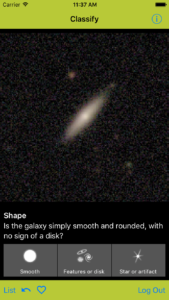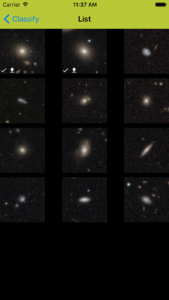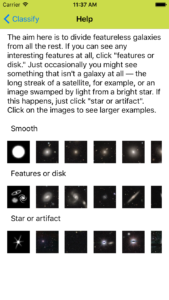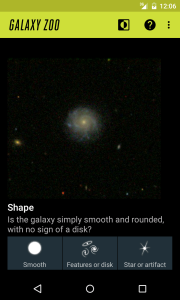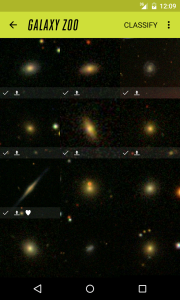Here are some notes about my experience adapting android-galaxyzoo to Material design for Android 5.0 (Lollipop) though I only used the most superficial parts of Material design.
AppCompat v21
Android 5.0 (Lollipop) has a new UI theme and some new APIs. However, for the next few years, almost everyone will use the slightly awkward AppCompat v21 compatibility API instead to achieve most of the same behavior on older devices too. Chris Banes wrote up a nice overview of AppCompat v21, some of which I mention here again for completeness.
I’m using Gradle, as should you, so I added this to the dependencies block in my app/build.gradle file. You’ll want to use the latest version.
compile "com.android.support:appcompat-v7:21.0.3"
Theme
First, I switched from the dark Holo theme to the (AppCompat) dark Material theme by changing the parent theme in my styles.xml. See the Toolbar section below about the use of the “.NoActionBar” versions of these themes.
- <style name="AppTheme" parent="android:Theme.Holo">
+ <style name="AppTheme" parent="Theme.AppCompat.NoActionBar">
If you were using the light theme, that would be:
- <style name="AppTheme" parent="android:Theme.Holo.Light">
+ <style name="AppTheme" parent="Theme.AppCompat.Light.NoActionBar">
Note that we don’t use the android: prefix with the AppCompat theme, because the theme is being bundled directly into our app via the appcompatv21 library.
I then specified the standard colorPrimary and colorAccent colors along with some more shenanigans to get the right text and icon colors in my toolbar.
I also used the TextAppearance_AppCompat_* widget styles instead of the regular textAppearance* style attributes, because it’s recommended in the Typography section of this official “Implementing Material Design in Your Android app” blog entry. However, I didn’t notice any difference in appearance, and I wonder why we wouldn’t just get the correct styles by just using the new overall theme.
I actually created a base style and two derived styles, to support Transitions – see below.
Toolbar
The new Toolbar widget replaces the ActionBar, though the documentation doesn’t actually say that yet. Generically, they are called the “App Bar” in the Material Design document. I’m not sure that I really got any benefit from using it because my App Bar doesn’t do anything special, but I wanted to use the latest API.
To use Toolbar instead of ActionBar, you should derive from the .NoActionBar version of the theme, such as Theme.AppCompat.NoActionBar, though I used the regular Theme.AppCompat for a long time without noticing any difference.
Then you’ll want to add a Toolbar widget to the Layout XML files for every activity. I did that by creating a toolbar.xml file
<?xml version="1.0" encoding="utf-8"?>
<android.support.v7.widget.Toolbar
   xmlns:android="http://schemas.android.com/apk/res/android"
   xmlns:app="http://schemas.android.com/apk/res-auto"
   android:id="@+id/toolbar"
   android:layout_width="match_parent"
   android:layout_height="wrap_content"
   android:background="@color/color_primary">
</android.support.v7.widget.Toolbar>
and then I just including that from all the activity layouts like so:
<include layout="@layout/toolbar" />
I also specified the app:theme and app:popupTheme to get the right text and icon colors in my toolbar.
To use this toolbar as the App Bar, you need to derive from ActionBarActivity and call its setSupportActionBar() method. I did that in a utility function, like so:
Toolbar toolbar = (Toolbar) activity.findViewById(R.id.toolbar);
activity.setSupportActionBar(toolbar);
RecyclerView
Android 5.0 adds the RecyclerView widget, available for older API levels via the support.recyclerview library. For instance, I added this to the dependencies block in my app/build.gradle file. You’ll want to use the latest version.
compile 'com.android.support:recyclerview-v7:21.0.0'
RecyclerView apparently replaces ListView and GridView, though the documentation doesn’t yet actually say that, adding confusion for new developers. I replaced my use of GridView with RecyclerView to get support for simple Material Design transitions.
Unfortunately, RecyclerView has no real cursor support, so it’s hard to use it to view data from a ContentProvider. This is particularly annoying because the API of ListView and GridView previously pushed us towards moving code into a ContentProvider. My own Cursor-based RecyclerView.Adapter is terribly inefficient and totally unsuitable for a large number of items.
There’s an awful lack of practical documentation or example code for RecyclerView, even for simple tasks like responding to a click. Until there’s an easier way, you’ll need some tedious boilerplate code to derive your RecyclerView.ViewHolder from View.OnClickListener and call setOnClickListener() on one of your child views.
Transitions
I wanted the typical move-and-scale transition that we see in Material Design apps, so that clicking on one of many items makes its image expand and move into the subsequent detail activity, and shrink back again when you go back.
To achieve this, I had to specify various settings in my theme, but only Android 5.0 (Lollipop) devices support these transition items, so I created a base theme in res/styles.xml, and derived from it:
<?xml version="1.0" encoding="utf-8"?>
<resources>
   <style name="AppTheme" parent="AppTheme.Base" />
   <style name="AppTheme.Base" parent="Theme.AppCompat.NoActionBar">
       <item name="colorPrimary">@color/color_primary</item>
...
I then created a styles.xml file just for API Level 21, by putting it in res/v21/styles.xml, where I derived from the base theme again:
<?xml version="1.0" encoding="utf-8"?>
<resources>
   <style name="AppTheme" parent="AppTheme.Base">
       <item name="android:windowContentTransitions">true</item>
       <item name="android:windowAllowEnterTransitionOverlap">true</item>
       <item name="android:windowAllowReturnTransitionOverlap">true</item>
       <!-- specify shared element transitions -->
       <item name="android:windowSharedElementEnterTransition">
           @transition/change_image_transform</item>
       <item name="android:windowSharedElementExitTransition">
           @transition/change_image_transform</item>
   </style>
</resources>
I then defined that change_image_transform transition in my res/transition/change_image_transform.xml file, like so:
<?xml version="1.0" encoding="utf-8"?>
<transitionSet>
   <changeBounds/>
   <changeImageTransform/>
</transitionSet>
To actually use this transition on images, I needed to specify the android:transitionName on the two ImageViews in the the layout XML files for the two Activities (Fragments in my case).
Mostly this was all voodoo which I put together gradually after finding clues scattered around the internet. I haven’t found a good official example that shows this.
Unfortunately, the transition doesn’t seem to work when the user presses the Up button on the toolbar instead of using the standard Back button, even though that’s indistinguishable from Back for most users in most activities.
Metrics and Keylines
I made a fair effort to adapt my margins and padding to fit in with the Material Design Metrics and Keylines, which wasn’t too hard.
Unfortunately, the standard Android Button’s appearance is just as usless for Material design as it was for the Holo theme. It has a fake margin around its inside edges, which is part of its background graphic rather than any adjustable margin or paddng property.
So, to make the button’s sides actually flush with other widgets, and to position them properly on the layout grid, I had to specify a custom background image or color. But then I lost the nice Material Design ripple effect. I hope someone knows how to do this properly.
Activity classes without Toolbar support
There are a few helpful derived activity classes, such as AccountAuthenticatorActivity and PreferenceActivity, but these haven’t been changed to derived from ActionBarActivity, so you can’t call setSupportActionBar() on them. They can’t be changed without breaking compatibility, so you’ll have to reimplement them in your code. It’s not a lot of code but it’s an unpleasant developer experience.
